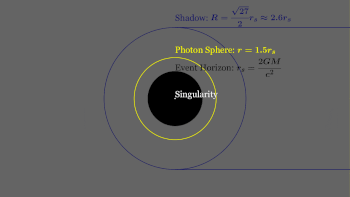
A photon sphere[1] or photon circle[2] arises in a neighbourhood of the event horizon of a black hole where gravity is so strong that emitted photons will not just bend around the black hole but also return to the point where they were emitted from and consequently display boomerang-like properties.[2] As the source emitting photons falls into the gravitational field towards the event horizon the shape of the trajectory of each boomerang photon changes, tending to a more circular form. At a critical value of the radial distance from the singularity the trajectory of a boomerang photon will take the form of a non-stable circular orbit, thus forming a photon circle and hence in aggregation a photon sphere. The circular photon orbit is said to be the last photon orbit.[3] The radius of the photon sphere, which is also the lower bound for any stable orbit, is, for a Schwarzschild black hole,
where G is the gravitational constant, M is the mass of the black hole, c is the speed of light in vacuum, and rs is the Schwarzschild radius (the radius of the event horizon); see below for a derivation of this result.
This equation entails that photon spheres can only exist in the space surrounding an extremely compact object (a black hole or possibly an "ultracompact" neutron star[4]).
The photon sphere is located farther from the center of a black hole than the event horizon. Within a photon sphere, it is possible to imagine a photon that is emitted (or reflected) from the back of one's head and, following an orbit of the black hole, is then intercepted by the person's eye, allowing one to see the back of the head, see e.g.[2]
For non-rotating black holes, the photon sphere is a sphere of radius 3/2 rs. There are no stable free-fall orbits that exist within or cross the photon sphere. Any free-fall orbit that crosses it from the outside spirals into the black hole. Any orbit that crosses it from the inside escapes to infinity or falls back in and spirals into the black hole. No unaccelerated orbit with a semi-major axis less than this distance is possible, but within the photon sphere, a constant acceleration will allow a spacecraft or probe to hover above the event horizon.
Another property of the photon sphere is centrifugal force (note: not centripetal) reversal.[5] Outside the photon sphere, the faster one orbits, the greater the outward force one feels. Centrifugal force falls to zero at the photon sphere, including non-freefall orbits at any speed, i.e. an object weighs the same no matter how fast it orbits, and becomes negative inside it. Inside the photon sphere, faster orbiting leads to greater weight or inward force. This has serious ramifications for the fluid dynamics of inward fluid flow.
A rotating black hole has two photon spheres. As a black hole rotates, it drags space with it. The photon sphere that is closer to the black hole is moving in the same direction as the rotation, whereas the photon sphere further away is moving against it. The greater the angular velocity of the rotation of a black hole, the greater the distance between the two photon spheres. Since the black hole has an axis of rotation, this only holds true if approaching the black hole in the direction of the equator. In a polar orbit, there is only one photon sphere. This is because when approaching at this angle, the possibility of traveling with or against the rotation does not exist. The rotation will instead cause the orbit to precess.[6]
- ^ Bennett, Jay (April 10, 2019). "Astronomers Capture First-Ever Image of a Supermassive Black Hole". Smithsonian.com. Smithsonian Institution. Archived from the original on April 13, 2021. Retrieved April 15, 2019.
- ^ a b c Cramer, Claes R. (1997). "Using the Uncharged Kerr Black Hole as a Gravitational Mirror". General Relativity and Gravitation. 29 (4): 445–454. arXiv:gr-qc/9510053. Bibcode:1997GReGr..29..445C. doi:10.1023/A:1018878515046. S2CID 9517046.
- ^ Levin, Janna (2019-04-10). "What the Sight of a Black Hole Means to a Black Hole Physicist". Quanta Magazine. Retrieved 2024-08-29.
a region defined by the location closest to the black hole where a beam of light could orbit on a circle, known as the "last photon orbit."
- ^ Nemiroff, Robert J.; Becker, Peter A.; Wood, Kent S. (April 1993). "Properties of ultracompact neutron stars". The Astrophysical Journal. 406: 590. doi:10.1086/172471. ISSN 0004-637X.
- ^ Abramowicz, Marek (1990). "Centrifugal-force reversal near a Schwarzschild black hole". Monthly Notices of the Royal Astronomical Society. 245: 720. Bibcode:1990MNRAS.245..720A.
- ^ Hirata, Christopher M. (December 2011). "Lecture XXVII: Kerr black holes: II. Precession, circular orbits, and stability" (PDF). Caltech. Retrieved 5 March 2018.
